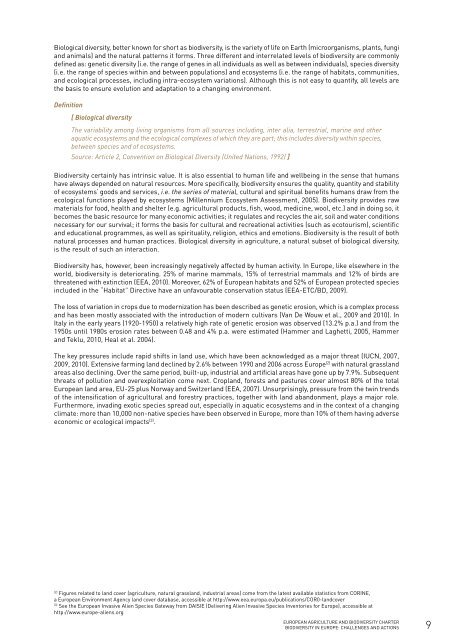agriculture - Reverse, European Project to Preserve Biodiversity
agriculture - Reverse, European Project to Preserve Biodiversity
agriculture - Reverse, European Project to Preserve Biodiversity
Create successful ePaper yourself
Turn your PDF publications into a flip-book with our unique Google optimized e-Paper software.
Biological diversity, better known for short as biodiversity, is the variety of life on Earth (microorganisms, plants, fungi<br />
and animals) and the natural patterns it forms. Three different and interrelated levels of biodiversity are commonly<br />
defined as: genetic diversity (i.e. the range of genes in all individuals as well as between individuals), species diversity<br />
(i.e. the range of species within and between populations) and ecosystems (i.e. the range of habitats, communities,<br />
and ecological processes, including intra-ecosystem variations). Although this is not easy <strong>to</strong> quantify, all levels are<br />
the basis <strong>to</strong> ensure evolution and adaptation <strong>to</strong> a changing environment.<br />
Definition<br />
[ Biological diversity<br />
The variability among living organisms from all sources including, inter alia, terrestrial, marine and other<br />
aquatic ecosystems and the ecological complexes of which they are part; this includes diversity within species,<br />
between species and of ecosystems.<br />
Source: Article 2, Convention on Biological Diversity (United Nations, 1992) ]<br />
<strong>Biodiversity</strong> certainly has intrinsic value. It is also essential <strong>to</strong> human life and wellbeing in the sense that humans<br />
have always depended on natural resources. More specifically, biodiversity ensures the quality, quantity and stability<br />
of ecosystems’ goods and services, i.e. the series of material, cultural and spiritual benefits humans draw from the<br />
ecological functions played by ecosystems (Millennium Ecosystem Assessment, 2005). <strong>Biodiversity</strong> provides raw<br />
materials for food, health and shelter (e.g. agricultural products, fish, wood, medicine, wool, etc.) and in doing so, it<br />
becomes the basic resource for many economic activities; it regulates and recycles the air, soil and water conditions<br />
necessary for our survival; it forms the basis for cultural and recreational activities (such as eco<strong>to</strong>urism), scientific<br />
and educational programmes, as well as spirituality, religion, ethics and emotions. <strong>Biodiversity</strong> is the result of both<br />
natural processes and human practices. Biological diversity in <strong>agriculture</strong>, a natural subset of biological diversity,<br />
is the result of such an interaction.<br />
<strong>Biodiversity</strong> has, however, been increasingly negatively affected by human activity. In Europe, like elsewhere in the<br />
world, biodiversity is deteriorating. 25% of marine mammals, 15% of terrestrial mammals and 12% of birds are<br />
threatened with extinction (EEA, 2010). Moreover, 62% of <strong>European</strong> habitats and 52% of <strong>European</strong> protected species<br />
included in the “Habitat” Directive have an unfavourable conservation status (EEA-ETC/BD, 2009).<br />
The loss of variation in crops due <strong>to</strong> modernization has been described as genetic erosion, which is a complex process<br />
and has been mostly associated with the introduction of modern cultivars (Van De Wouw et al., 2009 and 2010). In<br />
Italy in the early years (1920-1950) a relatively high rate of genetic erosion was observed (13.2% p.a.) and from the<br />
1950s until 1980s erosion rates between 0.48 and 4% p.a. were estimated (Hammer and Laghetti, 2005, Hammer<br />
and Teklu, 2010, Heal et al. 2004).<br />
The key pressures include rapid shifts in land use, which have been acknowledged as a major threat (IUCN, 2007,<br />
2009, 2010). Extensive farming land declined by 2.6% between 1990 and 2006 across Europe (2) with natural grassland<br />
areas also declining. Over the same period, built-up, industrial and artificial areas have gone up by 7.9%. Subsequent<br />
threats of pollution and overexploitation come next. Cropland, forests and pastures cover almost 80% of the <strong>to</strong>tal<br />
<strong>European</strong> land area, EU-25 plus Norway and Switzerland (EEA, 2007). Unsurprisingly, pressure from the twin trends<br />
of the intensification of agricultural and forestry practices, <strong>to</strong>gether with land abandonment, plays a major role.<br />
Furthermore, invading exotic species spread out, especially in aquatic ecosystems and in the context of a changing<br />
climate: more than 10,000 non-native species have been observed in Europe, more than 10% of them having adverse<br />
economic or ecological impacts (3) .<br />
(2) Figures related <strong>to</strong> land cover (<strong>agriculture</strong>, natural grassland, industrial areas) come from the latest available statistics from CORINE,<br />
a <strong>European</strong> Environment Agency land cover database, accessible at http://www.eea.europa.eu/publications/COR0-landcover<br />
(3) See the <strong>European</strong> Invasive Alien Species Gateway from DAISIE (Delivering Alien Invasive Species Inven<strong>to</strong>ries for Europe), accessible at<br />
http://www.europe-aliens.org<br />
EUROPEAN AGRICULTURE AND BIODIVERSITY CHARTER<br />
BIODIVERSITY IN EUROPE: CHALLENGES AND ACTIONS 9



